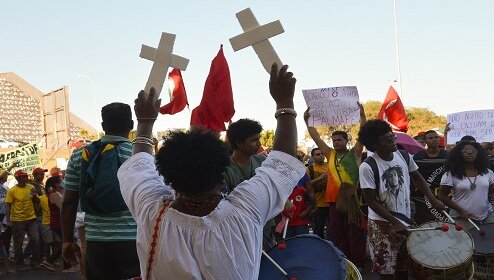Official data shows a significant increase in homicide rates in Brazil, especially among young, black people and women
By Wagner de Alcântara Aragão
In a ten-year period, the number of homicides in Brazil has grown by 23%, and this type of crime in the country represents 10% of the total homicides in the world. These and other tragic findings are in the Atlas of Violence 2017 of the Institute of Applied Economic Research (IPEA, in Portuguese), published in June and providing data from 2005 to 2015.
Elaborated in partnership with the Brazilian Public Security Forum, the Atlas of Violence points out that young people, women, the black population and the poor are the main victims. The study also shows that states in the North and Northeast regions recorded the highest increase in homicides. In the list of the most violent cities, there is a predominance of countryside municipalities, as well as peripheral areas of big cities.
According to the survey, a total of 59,080 homicides were officially registered in Brazil in 2015. This represents a rate of 28.9 deaths per 100,000 inhabitants. Ten years earlier, that is, in 2005, there had been 48,136 homicides in total, an increase of almost a quarter. The homicide rate, at that time, was around 25 for every 100,000 inhabitants.
One of the coordinators of the research, Daniel Cerqueira says the aggravation of violence in the decade “represents the continuity of a tragedy that comes from previous decades,” but has now reached an “unbearable” level. “We have reached an average of 59,000 to 60,000 homicides a year, more than 10% of homicides worldwide,” he points out.
WHY?
The significant increase in violence in the decade coincides with the recent period of economic growth, rise in family income, reduction of poverty, and expansion of basic services (health, education, sanitation, and housing). Therefore, the worsening of public security intrigues: why hasn’t the improvement in living conditions reflected in a safer society?
In Daniel Cerqueira’s evaluation, persistent social inequality, historical in Brazil, explains the scenario of violence. In addition, prejudice from racism and discrimination of the poorest. “We still live in a very unequal society with a history of racism. The people who die [victims of violence] are [mostly] young, black, low-educated, living in peripheries where there is a real ‘license to kill,’” argues the IPEA researcher.
The adoption of public policies that remain whoever is in charge is defended by Daniel Cerqueira as a way to fight violence, even with inequality and racism still impregnated in Brazilian society. The researcher highlights the cases of Pernambuco and Espírito Santo, “states that have been successful in reducing their homicide rates.” Between 2007 and 2013 alone, for example, Pernambuco saw a 36% reduction in the homicide rate. “Espírito Santo, since 1980, has been on the list of the five most violent states. In 2015 it fell to 13th.” The IPEA researcher warns, however, that in recent years such policies have been discontinued. “This year we had a strike by the Military Police of Espírito Santo,” he adds.
YOUNG AND BLACK PEOPLE
The Atlas of Violence identified that out of every 100 people murdered in Brazil, 71 are black – which corroborates Daniel Cerqueira’s argument that racism is one of the causes of death in Brazilian society. According to the study, blacks have a 23.5% greater chance of being murdered than Brazilians of other ethnicities, already discounted in this calculation effects such as age, schooling, sex, marital status and area of residence.
Another victim of the calamity in security, as noted by the researcher of IPEA, is the young people – generally, but mostly young black people. The homicide rate of the young population (15 to 29 years old) is 60.9 per 100,000 inhabitants, more than twice the average homicide rate of the Brazilian population in total (28.9 per 100,000 inhabitants).
The executive director of the Brazilian Public Security Forum, Samira Bueno, observes that violence against young people has been on the rise since 1980. “In the 2000s there was a hint of hope that this process would be interrupted, but that was not the case,” she says. For her, society’s sensitivity to this problem is lacking. “With 59,000 homicides in 2015, we have an average of 161 homicides a day. It is the equivalent of a Boeing 737. It is as if a plane crashes every day – this is the comparison of deaths of young people daily in Brazil. It is a lost youth.”
NORTH, NORTHEAST AND COUNTRYSIDE
The research coordinator points out that, territorially speaking, the violence in Brazil “has spread to the North and Northeast in the last ten, 15 years,” meaning that the homicide rate in most of these areas more than doubled between 2005 and 2015. The negative highlight is Rio Grande do Norte, where homicide rate has soared 232% in the period, rising from 13.5 per 100,000 inhabitants in 2005 to 44.9 in 2015. Next come Sergipe (134, 7% increase) and Maranhão (increase of 130.5%).
The violence also dissipated in the countryside. In order to compile a list of the most insecure municipalities in Brazil, IPEA analysed data from the Ministry of Health’s Mortality Information System (SIM, in Portuguese), referring to the interval from 2005 to 2015, and analysed information of the police records published in the 10th Brazilian Yearbook of Public Security, from the Brazilian Public Security Forum. “In order to list the 30 potentially more violent and less violent municipalities in Brazil in 2015, the study considered deaths from aggression (homicide) and violent deaths due to undetermined cause,” IPEA said in a statement.
The not honourable first place in the list of most violent was with Altamira, in Pará, with homicide rate 107, followed by Lauro de Freitas, in Bahia (97.7); Nossa Senhora do Socorro, in Sergipe (96.4); São José de Ribamar, in Maranhão (96.4); and Simões Filho, also in Bahia (92,3). “The North and Northeast regions have 22 municipalities in the ranking of the 30 most violent in 2015,” adds Daniel Cerqueira.
MESSY DEVELOPMENT
According to the researcher, what explains the occurrence of violent deaths to a greater extent in these countryside cities is the recent economic growth experienced in these regions. “Economic growth also attracts bad things like the illicit market,” says Daniel Cerqueira.
The research coordinator explains: “There was a sharp increase in income in the countryside of Brazil. With this, the drug trafficking business has become viable in these areas. These illicit markets are causing many deaths, and conflicts, as they originate in illicit business, cannot be decided in court, but in the bullet.” Cerqueira ponders that this is a hypothesis, but “quite plausible” – IPEA is developing a study on this issue, and the survey so far points to a confirmation of this hypothesis.
Side effects also result from the lack or inefficiency of public policies that ensure a more orderly economic growth. The Atlas exemplifies the case of Altamira, the city that leads the list of the most violent. The municipality was, from the economic point of view, benefited from the construction of the Belo Monte Power Plant, which generated jobs and income; the expansion, however, was disorderly and not accompanied by investments in policies that would ensure that such expansion took place in an egalitarian manner. A small portion benefited fully from economic development, while the majority was kept on the margins of this process.
POLICE VIOLENCE
The Altas of Violence also investigated the deaths caused by police action. The document criticizes the logic of the Brazilian police system, based on truculence and repression. This is what the executive director of the Brazilian Public Security Forum Samira Bueno calls “state violence.” It is a logic that is reflected not only in the victims of police action, but also in the number of police deaths. “What happens is that usually the police officer kills on duty, and dies out of service,” says Samira Bueno.
Atlas data on deaths resulting from police intervention have two variations: those analysed by the Ministry of Health’s Mortality Information System in the category of “legal interventions and war operations” (942 in 2015) and the numbers gathered by the Forum (3,320) across the country. The states that recorded the highest number of such homicides in the first variation in 2015 were Rio de Janeiro (281), São Paulo (277) and Bahia (225). According to data from the Brazilian Public Security Forum, 848 deaths were recorded in São Paulo resulting from police intervention, 645 in Rio de Janeiro and 299 in Bahia.
The team that developed Altas criticized the shortage of more consistent sources of data on state violence (practiced by the police forces) and advocates reformulation in the modus operandi of Brazilian police. “In addition to the need to review the registration protocols for these cases by the health sector, we must insist on changing a model of public security that, if it does not promote, is conniving with the abusive use of lethal force and summary executions, at the same time in which exposes and victimizes more and more its agents”, denounces the study.



